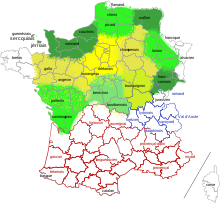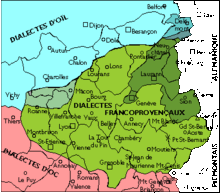Romance dialects in Alsace
The Romance dialects in Alsace include, on the one hand, the long-established autochthonous Romance dialects in the Vosges and Sundgau , and on the other hand those French dialects that are or were spoken by the other inhabitants of the Alsace region .
The old Romanesque dialect areas of Alsace
Main articles: Langues d'oïl , Lorraine (Romansh) , Franc-Comtois , Which , Patois
The Romance dialects that are autochthonous in various areas of what is now Alsace belong to the Langues d'oïl (see also Patois ). The Franco-Provencal dialects in the extreme south-west of Alsace are sometimes counted among them, sometimes not. The Romance dialects in the Vosges belong to the Lorraine-Romance dialect area (see also Which ), those in southern Alsace to the Franc-Comtois dialect area .
The Romansh-Germanic language border area behind it arose in late antiquity and the early Middle Ages and was mostly relatively stable. A major change took place after the Thirty Years' War : regions in the Breuschtal (and Lorraine) that had been depopulated by the war and were formerly predominantly Germanic-speaking regions were (re) populated by Romansh speakers and subsequently retained their language.
The communities of the traditional Romansh-speaking areas in Alsace thus partly have a German-speaking prehistory or had traditional German-speaking parts or a bilingual character - details on this can be found in the local articles and in border towns of the Alemannic dialect area . Traditionally French or Romansh-speaking areas and municipalities of today's Alsace region in this sense are (from north to south):
-
Lorraine (Romansh) :
- Large parts of the Breuschtal . Originally the municipalities of Saales , Bourg-Bruche , Saulxures , Ranrupt , Colroy-la-Roche and Grandfontaine . In the 17th century the communities Bellefosse , Blancherupt , Belmont , Waldersbach , Fouday , Solbach , Wildersbach , Neuviller-la-Roche , Rothau , Barembach , Schirmeck , Russ , Wisches and Lutzelhouse were added . The partly extensive areas of the municipalities of Plaine , La Broque and Saint-Blaise-la-Roche have an unclear position .
- Smaller parts of the hamlet valley , namely the municipalities of Urbeis , Lalaye , Fouchy , Breitenau and - partially since the 17th century - Steige .
- The valley of the Lièpvrette (Leber) with the communes of Sainte-Marie-aux-Mines , Sainte-Croix-aux-Mines , Lièpvre and Rombach-le-Franc .
- The area around Lapoutroie with the municipalities of Lapoutroie, Labaroche , Orbey , Le Bonhomme , Fréland and Aubure .
-
Franc-Comtois (to Franco-Provençal ):
- The villages of Bellemagny , Bretten , Eteimbes and Saint-Cosme .
- The area around Montreux-Vieux with the municipalities of Montreux-Vieux, Montreux-Jeune , Magny , Romagny , Valdieu-Lutran and Chavannes-sur-l'Étang .
- The villages of Courtavon and Levoncourt .
The French of Alsace
Especially in the 20th century, Alsace switched to the French language (French: Francisation ). Similar processes are comparable in Brittany or Ireland . As a result, there are no Romansh or French dialects in the formerly German-speaking area. The neighboring dialect groups ( Lorrain in the west and Franc-Comtois in the southwest) only had a special influence on the traditional Romansh-speaking places in Alsace.
Today's dialects and varieties of French are very close to standard French. This applies to the areas of all major historical-linguistic groups ( Langues d'oïl , Langues d'Oc / Occitan , Franco-Provençal ). However, there are slight differences between the French-speaking countries, and some regions of France also have a relatively strong variety in French. This includes the French of Alsace ( Français d'Alsace / Parler alsacien ).
The French of Alsace is not so much an expression of established local dialects, but rather some typical deviations from standard French in pronunciation , vocabulary and syntax . It therefore has more of the character of a regional colloquial language, which has its cause in the astrate or substratum of the previously predominant German or regional German dialects. The latter are quite different, but dominated by Upper Rhine-Manish and summarized in Alsatian .
Examples of French in Alsace:
- Jeune is pronounced like cheûne
- Manteau de pluie (from raincoat , instead of Impérmeable )
- Poutzer (from cleaning , instead of éppousseter )
- Ça donne (from There is , instead of Il ya )
- Donc may as pourtant be used (dt. But , for example. Je te l'ai dit donc! - That's what I told you! )
- Viens chez Maman ( Come to Mama )
- Je vais vous relier (on the phone: I will connect you instead of Je vais vous passer ... )
Certain peculiarities of the French of Alsace have found their way into the whole of French (e.g. Gaell? Or Gall? - in the sense of not true? Or right ? - for Hein? Or N'est-ce pas? ).
Remarks
- ↑ There were other areas in Alsace that were resettled, often adjacent to those who spoke Romansh, but which were then predominantly repopulated by speakers of Germanic dialects. It is also plausible that newcomers have Romanized or Germanized depending on where they live, sometimes not immediately in the first generation. For some villages a kind of "bilingualism" is also likely, with a Romanesque core village and Germanic hamlets and farms (or vice versa). To the north of Dabo (Dagsburg) there are also some former Lorraine plateau-speaking villages that were repopulated by Alsatian-German speakers and where the dialect still today, or at least until recently, has predominantly Alsatian characteristics.


